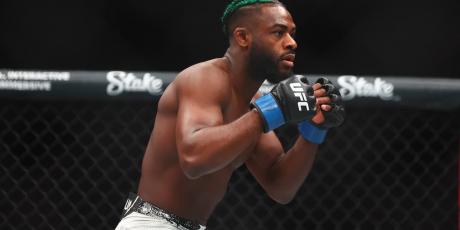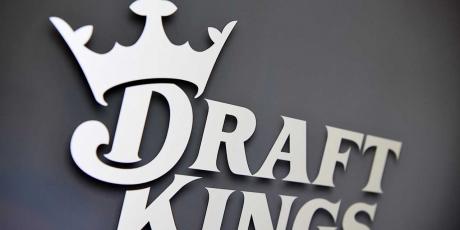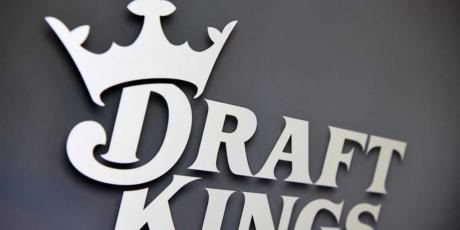FFPC Win Rates: Quarterbacks

The quarterback position is one of the toughest to draft in best ball formats. We focus on target share for wide receivers, and running backs just need a path to touches and scoring opportunities. But with quarterbacks, we consider everything. Rushing ability, offensive line quality, options at pass-catcher, and even the number of dome games enter the conversation when drafting a quarterback. However, the opportunity cost required to draft them can be the most critical attribute.
FFPC Win Rates Series: RBs | WRs
I recently wrote about roster construction and tips for drafting optimal teams. Despite the fact that the majority of the Top-10 builds used three quarterbacks, strategies on when to draft them can be difficult to contextualize. To help, I looked back at the last two seasons to measure how opportunity cost plays a role at each phase of the draft and how we can roll this into our strategies for drafting quarterbacks this offseason.
Highest QB Win Rates
| Rank | Player | Win Rate % | ADP |
|---|---|---|---|
| 1 | Josh Allen | 16.50% | 8.12 |
| 2 | Aaron Rodgers | 12.90% | 10.10 |
| 3 | Tom Brady | 12.10% | 10.04 |
| 4 | Kirk Cousins | 11.30% | 14.11 |
| 5 | Justin Herbert | 11.10% | 25.08 |
| 6 | Deshaun Watson | 10.60% | 7.02 |
| 7 | Ryan Tannehill | 10.50% | 13.11 |
| 8 | Kyler Murray | 10.40% | 6.07 |
| 9 | Russell Wilson | 10.30% | 6.12 |
| 10 | Ben Roethlisberger | 10.00% | 12.03 |
| 11 | Patrick Mahomes | 9.50% | 2.12 |
| 12 | Teddy Bridgewater | 9.00% | 15.08 |
No surprises here. With the exception of Teddy Bridgewater, the Top 12 in win percentage mimicked the Top-12 ranks in QB fantasy scoring. The draft community is typically sharp in identifying who the top options are at the position. However, it’s finding value within their ADPs that separated most of the winning teams from their league.
TJ Hernandez called Josh Allen '[2020's] Lamar Jackson' and couldn’t have been more accurate. Allen’s QB7 ADP but QB1 finish was a clear advantage for drafters in 2020. His ability to nearly match the fantasy output of guys like Kyler Murray and Patrick Mahomes while being drafted multiple rounds later is what we look for every year. Not the next overall QB1, but a quarterback that can offset his opportunity cost since just three quarterbacks from the early rounds made it into the Top 12.
From 2018 to 2020, on average seven signal-callers were drafted by the eighth round (the most was eight in 2019). We now operate in a dystopian market where 17 passers can be taken by the 96th pick. ‘Tom Brady or D.J. Chark’ is an actual decision drafters have to make in 2021. Let’s break down the draft into phases and see how opportunity cost from a historical perspective should guide our decisions this year.
Early Rounds
| Rank | Player | Win Rate % | ADP |
|---|---|---|---|
| 8 | Kyler Murray | 10.40% | 6.07 |
| 9 | Russell Wilson | 10.30% | 6.12 |
| 11 | Patrick Mahomes | 9.50% | 2.12 |
Mahomes, Wilson, and Murray being the only passers from the early rounds to make it into the Top 12 in win percentage make sense given their production profiles in 2020. Mahomes was third amongst all passers in EPA per play and seventh in TD rate. Wilson was second in both total touchdowns (40) and TD rate (7.2%) along with being fourth in QB rushing yards. Kyler wasn’t nearly as efficient as a passer (15th in EPA per play), but his mobility more than compensated. He was second in both rushing yards and touchdowns which added 9.2 PPG to his weekly output. So while both were able to meet the expectations of their draft cost, it’s difficult to bank on the same for others drafted in the same range.
I often bring up opportunity cost because it’s one of the few metrics that forces drafters to look at their draft holistically. Instead of getting caught in a positional run, comparing values across positions can likely put you on an optimal path when building a team. And the early rounds are critical. To draft a quarterback early doesn’t just mean they need to outperform their peers, they also need to outscore players at other positions in order to be a part of a winning roster.


I compared the ADPs and total fantasy points scored across WRs, RBs, and Top-12 QBs over the last two seasons. The fact that quarterbacks outscored WRs and RBs just scratches the surface. The gap between QBs and RBs or WRs is where we can start to measure opportunity cost by looking at what you need from your passer relative to the other positions. Early-round QBs outscored RBs and WRs by an average of 12.8 and 11.1 points per game. Their weekly positional rank included an average of 2 QB1-overall performances, four finishes within the Top 3, and 10 Top-12 scores. A few spike weeks from an early-round quarterback alone won’t give you an edge. It’s the spike weeks combined with sustained top-tier play that will justify drafting a quarterback prior to the seventh round.
We’ve looked at the data from a results perspective (i.e., how they finished), but let’s flip the view to their opportunity (i.e., on-field usage). Mahomes and Wilson led offenses that were in the Top 10 for both neutral and red-zone passing rate. They also averaged 4.4 rushing attempts per game which added 3.2 fantasy PPG to their passing point totals. Murray and 2019 Watson took advantage of their rushing opportunities. Last year’s Cardinals and 2019’s Texans both finished in the Bottom 10 in neutral passing rate. However, both passers were Top 6 in the percentage of the team’s red zone rushing attempts with a minimum of 11.3%. In both cases, a rushing component (either large or small) was a part of the QB’s skill set. If you’re looking to invest in the position early, high volume (either passing or rushing) has to be in the range of outcomes for the pick to hit.
Favorite Early-Round QBs for 2021: Dak Prescott (ADP 48.0), Justin Herbert (ADP 54.0), Jalen Hurts (ADP 68.0)
Middle Rounds
| Rank | Player | Win Rate % | ADP |
|---|---|---|---|
| 1 | Josh Allen | 16.50% | 8.12 |
| 2 | Aaron Rodgers | 12.90% | 10.10 |
| 3 | Tom Brady | 12.10% | 10.04 |
| 4 | Kirk Cousins | 11.30% | 14.11 |
| 6 | Deshaun Watson | 10.60% | 7.02 |
| 7 | Ryan Tannehill | 10.50% | 13.10 |
| 10 | Ben Roethlisberger | 10.00% | 12.03 |
| 12 | Teddy Bridgewater | 9.00% | 15.08 |
The middle rounds are packed with the weekly favorites at QB. As I noted earlier, Josh Allen blew past the competition as Buffalo quickly turned their offense around with the addition of Stefon Diggs. Allen finished fourth in EPA per play with the second-most touchdowns. His peers in this phase of the draft had similar passing profiles.
| Top 12 Metric | No. of QBs |
|---|---|
| EPA per Play | 6 |
| TD Rate | 7 |
| Rushing Yards | 3 |
| Rushing TDs | 5 |
Being an efficient passer outweighed potential rushing production for quarterbacks in the middle rounds, but it was still a much-needed complement. The primary reason is that the opportunity cost associated with drafting a quarterback in this part of the draft has historically been low.
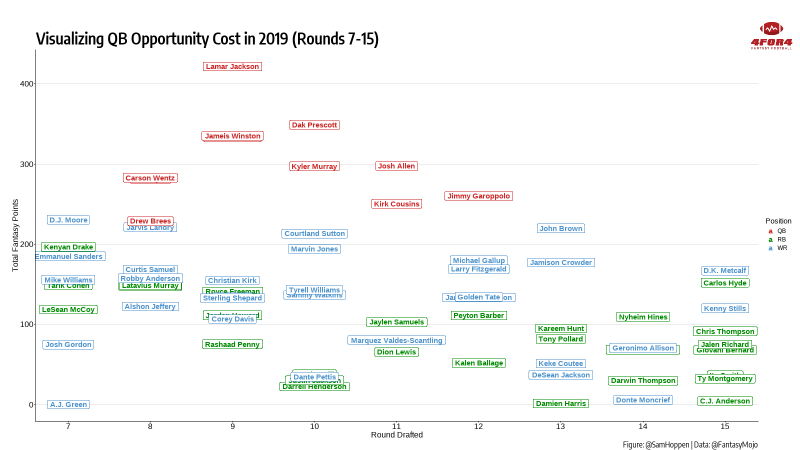
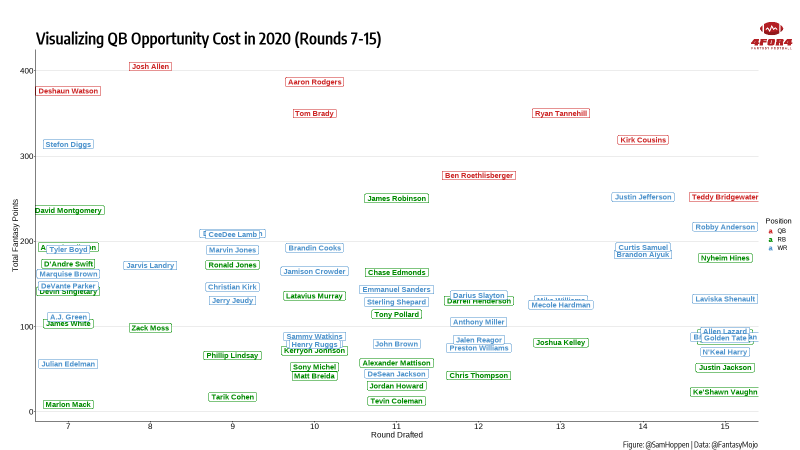
Total fantasy points for the core positions take a noticeable decline when compared to the early rounds with 24.2% of the players drafted averaging more than 10 PPG. The drop in production at RB and WR lowers the opportunity cost for taking a QB. So, unlike the top-tier passers, the mid-round options can be just good rather than great. But we do need those spike weeks. Quarterbacks in this range had an average weekly positional rank of one QB1-overall performance, two finishes within the Top 3, and eight Top-12 scores. So we are seeing a relaxation in the need for elite production, but sustained quality across a full season is still required.
Usage profiles for quarterbacks are a bit more flexible at this stage of the draft with multiple archetypes supported. Watson, Allen, and Brady were all part of squads with Top-12 rates in both neutral and red-zone passing. Matt Ryan and Drew Brees operated similarly in 2019, but Kirk Cousins boosted his efficiency through an increase in deep-ball rate (12th in the league). Like Ryan Tannehill or Lamar Jackson in 2019, Cousins’ ability to hit down-field throws resulted in an increase in TD rate pulling him into fantasy relevance despite the lack of attempts (29th in neutral passing rate).
However, the key point is the range of expectations for passers drafted in the middle rounds. QBs taken here have averaged 19.9 fantasy PPG which would have been the QB13 in 2020. Essentially, established and fringe QB1’s should be in your player pool. While finding the next Josh Allen should always be our objective, finding a quarterback that can vault into the QB1 ranks can significantly increase our chances of success.
Favorite Mid-Round QBs for 2021: Tua Tagovailoa (ADP 104.0), Daniel Jones (ADP 123.0), and Justin Fields (ADP 162.0)
Late Rounds
| Rank | Player | Win Rate % | ADP |
|---|---|---|---|
| 5 | Justin Herbert | 11.10% | 25.08 |
Herbert is a unicorn. After polarizing pre-draft evaluations to his quick ascension into the starting role, Herbert's value can’t be overstated. The problem was that he was generally overlooked given his situation prior to the start of the season. Through Week 16, Herbert was 16th in EPA per play (right behind Kyler Murray) with more passing yards than Russell Wilson on a team that was at the league average in terms of neutral and red-zone passing rate. Herbert also added 2.9 fantasy PPG with his legs which helped him edge out Murray for the QB1 title in Week 7. You couldn’t ask for more from a 25th -round pick.
Opportunity cost is a non-factor this late in the draft. Defense and kicker should be the primary focus with speculative darts thrown at the core positions. While we always seem to think guys like Mitchell Trubisky fit the mold for our third quarterback, Herbert should force us to rethink such an approach.

Herbert is the only quarterback with a late-round ADP to make it into the Top 12 in win percentage over the last two seasons. In his 15 starts, he had one QB1-overall finish along with two weeks in the Top 3 and eight Top-12 appearances. His weekly ranks are directly comparable to Russell Wilson who was drafted 19 rounds earlier. But the takeaway is less about the results and more about the player profile we can use for future drafts.
Late-round quarterbacks are typically viewed as bridge options. By then, at least two will be on your roster so a guy that will start a few games for your final QB appears viable. But that approach shifts the burden of production to your rostered QBs. Instead, identifying full-season starters with mobility in their profile would offset the risk of waiting until the later rounds.
Rookie quarterbacks tend to fall into this area of the draft given their uncertainty. Trevor Lawrence is the exception and Justin Fields has crept into the middle rounds, but Zach Wilson and Trey Lance are available in this area of the draft. Given the rumors surrounding both, drafting a rookie or adjusting your strategy to have all quarterbacks drafted prior to the later rounds would be more viable than the other options typically available.
Favorite Late-Round QBs for 2021: Zach Wilson (ADP 178.0) and Taysom Hill (249.0)
Bottom Line
- Quarterback ADP is more aggressive than in years past, with 17 passers typically drafted by the eighth round in 2021.
- The Top 12 in win percentage over the last two seasons has featured just four QBs drafted in the early rounds (Rounds 1-6).
- Early-round QBs outscored RBs and WRs drafted in the same range by an average of 12.8 and 11.1 fantasy PPG. Early-round passers must have at least two QB1-overall performances along with multiple Top-12 scores in their range of outcomes to be considered viable. Typical usage profiles included quarterbacks in the Top 10 in either neutral/red-zone passing rate or Top 6 in red-zone rush share.
- Mid-round QBs still need their spike weeks (at least one QB1-overall finish), but consistent Top-12 finishes will suffice. Signal callers in this range have averaged 19.9 fantasy PPG over the last two seasons. Half of the quarterbacks drafted in the middle rounds were in the Top 12 in either QB rushing yards or touchdowns.
- Late-round QBs need to be mobile and have a path to the majority of their team’s starts. Rookies may be viable early in the offseason without knowing their draft capital or landing spot.

